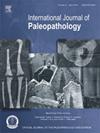Spavin in modern and archaeological cattle: Reassessing its association with traction use
IF 1.5
3区 地球科学
Q3 PALEONTOLOGY
引用次数: 0
Abstract
Objective
To investigate the correlations of biological factors, including age, body size, and sex, with the occurrence of spavin, demonstrating that using spavin to indicate cattle use for draught work from archaeological sites is questionable.
Materials
Metatarsals from 126 modern non-draught cattle kept under similar conditions, along with published data of 18 draught oxen.
Results
This study demonstrates that spavin strongly correlates with age, body weight, and to some extent, restricted movement, with no observed correlation with sex in non-draught cattle. No significant difference in spavin prevalence was found between the draught and non-draught groups.
Conclusions
Age, body weight, and potentially restricted movement, may partly explain the higher frequency of spavin observed in historic times compared to prehistory, reflecting changes in livestock management. The potential influence of traction on spavin should not be ignored, but this paper argues that the connection between spavin and draught use is primarily mediated by age and other factors.
Significance
This study presents the first systematic analysis of one of the most frequently described palaeopathology in cattle, suggesting that spavin should not be uncritically used to identify draught cattle.
Limitation
We have not found a significant relationship between sex and spavin occurrence, but this is worth further exploration.
Suggestions for further research
Sexing pathological metatarsals from archaeological sites in future works could contribute to clarifying the causes of spavin.
西班牙在现代和考古牛:重新评估其与牵引使用的关系
目的探讨年龄、体型和性别等生物因素与西班牙语发生的相关性,证明用西班牙语来表示考古遗址的役畜用途是值得怀疑的。资料:在类似条件下饲养的126头现代非役用牛的跖骨,以及已发表的18头役用牛的数据。结果本研究表明,在非役畜中,西班牙语与年龄、体重以及在一定程度上限制运动密切相关,而与性别没有观察到相关性。在干旱组和非干旱组之间,西班牙患病率没有显著差异。结论:体重、体重和潜在的活动受限可能部分解释了历史时期与史前相比西班牙语发生频率更高的原因,反映了牲畜管理的变化。牵引力对西班牙语的潜在影响不容忽视,但本文认为西班牙语与牵引力之间的联系主要是由年龄和其他因素介导的。意义本研究首次对牛中最常见的古病理学之一进行了系统分析,表明不应不加批判地使用西班牙语来识别旱牛。我们尚未发现性别与西班牙语发生之间的显著关系,但这值得进一步探索。进一步研究的建议:在今后的工作中,对考古遗址的病理跖骨进行性别鉴定将有助于弄清西班牙的原因。
本文章由计算机程序翻译,如有差异,请以英文原文为准。
求助全文
约1分钟内获得全文
求助全文
来源期刊

International Journal of Paleopathology
PALEONTOLOGY-PATHOLOGY
CiteScore
2.90
自引率
25.00%
发文量
43
期刊介绍:
Paleopathology is the study and application of methods and techniques for investigating diseases and related conditions from skeletal and soft tissue remains. The International Journal of Paleopathology (IJPP) will publish original and significant articles on human and animal (including hominids) disease, based upon the study of physical remains, including osseous, dental, and preserved soft tissues at a range of methodological levels, from direct observation to molecular, chemical, histological and radiographic analysis. Discussion of ways in which these methods can be applied to the reconstruction of health, disease and life histories in the past is central to the discipline, so the journal would also encourage papers covering interpretive and theoretical issues, and those that place the study of disease at the centre of a bioarchaeological or biocultural approach. Papers dealing with historical evidence relating to disease in the past (rather than history of medicine) will also be published. The journal will also accept significant studies that applied previously developed techniques to new materials, setting the research in the context of current debates on past human and animal health.
 求助内容:
求助内容: 应助结果提醒方式:
应助结果提醒方式:


